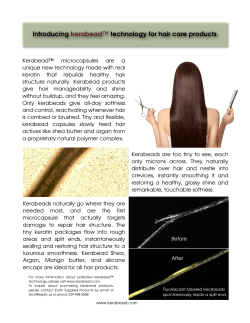
Possible reference values of carcinogenic elements (As, Be, Cd, Ni
P024 Possible reference values of carcinogenic elements (As, Be, Cd, Ni) in the hair of children aged 6-9 years of the Community of Madrid, Spain Antonio Peña-Fernández1, Marίa Jose González-Muñoz1 and Marίa del Carmen Lobo-Bedmar2 1 University of Alcalá, Alcalá de Henares, Spain 2 Instituto Madrileño de Investigación y Desarrollo Rural Agrario y Alimentario (IMIDRA), Alcalá de Henares, Spain Human hair can be used as a biomarker of environmental exposure to metals and metalloids (trace elements) but to date very few studies have suggested reference values of trace elements in hair. This is because of the different factors that affect the presence of metals in human hair such as age, gender, ethnicity, etc. However, the application of strict inclusion criteria to select participants in biomonitoring surveys of human hair could reduce the impact of these factors (Peña-Fernández, 2011; Peña-Fernández et al., 2014). A biomonitoring study was conducted to establish the possible reference values of arsenic (As), beryllium (Be), cadmium (Cd) and nickel (Ni) in the hair of children aged 6-9 years from Alcalá de Henares, Community of Madrid (Spain). Hair samples were taken from the scalp close to the occipital region in 117 healthy and non-exposed children who met the strict inclusion criteria. The levels of these elements were monitored by ICP-OES. Concentrations of As and Be were below the detection level. Reference values were established using the methodology and recommendations suggested by the International Union of Pure and Applied Chemistry (IUPAC). The 95% confidence intervals for 95th population percentile (CI-PP95) for each carcinogenic element were as follows: <0.02 µg/g for As, <0.05 µg/g for Be, 0.83-1.03 µg/g for Cd, and 0.96-1.12 µg/g for Ni. These reference values may be used to identify whether any child that lives in the Community of Madrid has been exposed. These values might also be used in other same-age populations with similar background exposure and life-styles.
© Copyright 2025





















